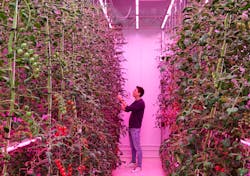Yet another reason why commercial horticultural outfits might want to turn to indoor growing for at least a portion of the cycle: Propagation can be superior to the more conventional techniques generally used for plants’ early stages.
In an online tour of its Philips GrowWise Research Center in Eindhoven, Holland today, Signify pointed out that indoor propagation, away from the weather extremes of greenhouses or other protected outdoor environments, has yielded heartier young tomatoes, cucumbers, bell peppers, and lettuces compared to brethren versions nurtured outdoors.
Signify did not issue any scientific findings. Its assessment of propagation success had more of an anecdotal flavor, but one that it backed up through the examples of different crops that it has nurtured at GrowWise. The facility houses a set of experimental indoor, LED-lit growing rooms at Signify headquarters, where the company examines different light recipes for various stages of plants. Those stages include propagation — the initial phase of growth, often from grafting in the case of GrowWise.
Signify indoor farming specialist Stefan van de Voort said that the company has watched closely to see whether the pampered indoor baby plants would suffer when moved to rougher conditions for the next stage of growth.
“You would maybe think that they might get a shock when you transfer them outside, but it’s actually the other way around — they don’t have any signs of stress, so they are very active and very strong, so they get a bigger head start,” van de Voort said.
“We see that the plants from indoor are more active and the root structure is more active,” he noted.
With energy prices high at the moment, growers are currently balking at buying LED lighting, be it for indoor farms which have no sunlight or for supplemental lighting in greenhouses.
But van de Voort suggested that the benefits afforded at the propagation stage could be a reason to go with LED-lit indoor growing at least during that period of a plant’s life.
“You can use it for a hybrid type of set-up, where you do the first phases of the plant in an indoor farm because there are a whole lot of plants per square meter, so the costs per plant are minimal, (and) you can increase the quality of your product year round,” he said. “Then in the later phases you can transplant them into the greenhouse or an open field, and they can have a head start compared to traditionally propagated plants.”
The concept of using LEDs at the propagation stage is not new, and has proven successful in greenhouses with lettuce and tomatoes.
As LEDs Magazine pointed out earlier this week, horticultural lighting vendors are ramping up their educational efforts to keep interest alive among potential customers during the industry’s current slowdown.
Today’s virtual tour of GrowWise for outsiders was part of that marketing outreach. It covered not just propagation but many aspects of indoor growing completely removed from sunlight.
During the tour, van de Voort also pointed out that indoor farming can entail more than stacked racks in “vertical farm” set-ups. It can also house high-wire arrangements, such as with tomatoes and cucumbers that Signify has grown at the center using both top toplighting and interlighting, he said.
MARK HALPER is a contributing editor for LEDs Magazine, and an energy, technology, and business journalist ([email protected]).
Follow our LinkedIn page for our latest news updates, contributed articles, and commentary, and our Facebook page for events announcements and more. You can also find us on Twitter.






